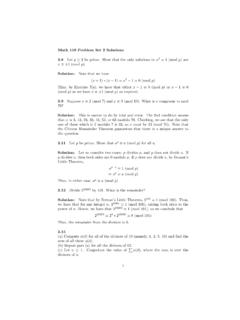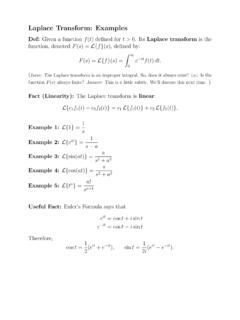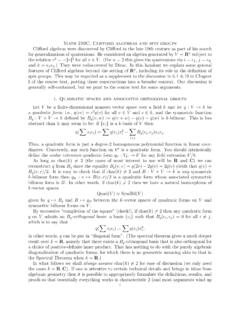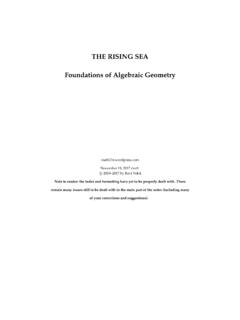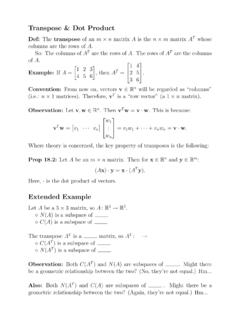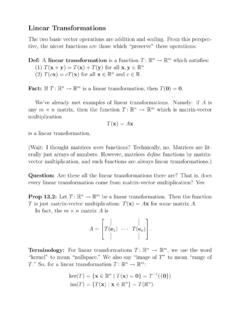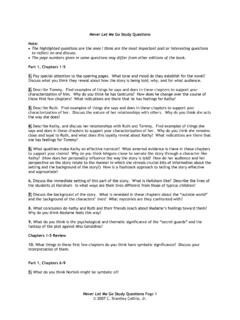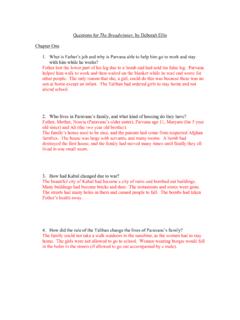Transcription of The Topology of Fiber Bundles Lecture Notes
1 The Topology of Fiber BundlesLecture NotesRalph L. CohenDept. of MathematicsStanford UniversityContentsIntroductionvChapter 1. Locally Trival Fibrations11. Definitions and Vector Lie Groups and Principal clutching Functions and Structure Groups152. Pull Backs and bundle Pull The tangent bundle of Projective K - Differential Connections and The Levi - Civita Connection39 chapter 2. Classification of Bundles451. The homotopy invariance of Fiber bundles452. Universal Bundles and classifying spaces503.
2 Classifying Gauge Groups604. Existence of universal Bundles : the Milnor join construction and the simplicial The join Simplicial spaces and classifying spaces665. Some Line Bundles over projective Structures on Bundles and homotopy Embedded Bundles Representations and flat connections78 chapter 3. Characteristic Classes811. Preliminaries812. Chern Classes and Stiefel - Whitney The Thom Isomorphism The Gysin Proof of theorem The product formula and the splitting principle974. Characteristic classes of Normal Bundles and immersions1055.
3 Pontrjagin Orientations and Complex Pontrjagin Oriented characteristic classes1146. Connections, Curvature, and Characteristic Classes115 chapter 4. Homotopy Theory of Fibrations1251. Homotopy Groups1252. Fibrations1303. Obstruction Theory1354. Eilenberg - MacLane Obstruction theory and the existence of Eilenberg - MacLane The Hopf - Whitney theorem and the classification theorem for Eilenberg - MacLanespaces1445. Spectral The spectral sequence of a The Leray - Serre spectral sequence for a Applications I: The Hurewicz Applications II:H ( Sn) andH (U(n)) Applications III:SpinandSpinCstructures165 Bibliography171 IntroductionFiber Bundles and more general fibrations are basic objects of study in many areas of mathe-matics.
4 A Fiber bundle with base spaceBand fiberFcan be viewed as a parameterized family ofobjects, each isomorphic toF, where the family is parameterized by points inB. For example avector bundle over a spaceBis a parameterized family of vector spacesVx, one for each pointx a Lie groupG, a principalG- bundle over a spaceBcan be viewed as a parameterized familyof spacesFx, each with a free, transitive action ofG(so in particular eachFxis homeomorphic toG). A covering space is also an example of a Fiber bundle where the fibers are discrete sets.
5 Sheavesand fibrations are generalizations of the notion of Fiber Bundles and are fundamental objects inAlgebraic Geometry and Algebraic Topology , Bundles and fibrations encode topological and geometric information about the spacesover which they are defined. Here are but a few observations on their impact in mathematics. A structure such as an orientation, a framing, an almost complex structure, a spin structure,and a Riemannian metric are all constructions on the the tangent bundle of a manifold. The exact sequence in homotopy groups, and the Leray - Serre spectral sequence for ho-mology groups of a fibration have been basic tools in Algebraic Topology for nearly half acentury.
6 Understanding algebraic sections of algebraic Bundles over a projective variety is a basicgoal in algebraic geometry. K- theory, a type of classification of vector Bundles over a topological space is at the sametime an important homotopy invariant of the space, and a quantity for encoding indexinformation about elliptic differential operators. The Yang - Mills partial differential equations are defined on the space of connections ona principal bundle over a Riemannian two dimensional or four dimensional manifold. Theproperties of the solution space have had a great impact on our understanding of fourdimensional Differential Topology in the last fifteen these Notes we will study basic topological properties of Fiber Bundles and fibrations.
7 We willstudy their definitions, and constructions, while considering many examples. A main goal of thesenotes is to develop the Topology needed to classify principal Bundles , and to discuss various models oftheir classifying spaces. We will compute the cohomology of the classifying spaces ofO(n) andU(n),and use them to studyK- theory. These calculations will also allow us to describe characteristicvviINTRODUCTION classes for these Bundles which we use in a variety of applications including the study of framings,orientations, almost complex structures,SpinandSpinC- structures, vector fields, and immersionsof manifolds.
8 We will also discuss the Chern-Weil method of defining characteristic classes (viathe curvature of a connection), and show how allU(n) - characteristic classes can be defined thisway. We also use these techniques to consider the topological implications when a bundle admitsa flat connection. Finally, we study the algebraic Topology of fibrations. This includes the exactsequence in homotopy groups of a fibration, general obstruction theory, including the interpretationof characteristic classes as obstructions to the existence of cross sections, and the construction andproperties of Eilenberg - MacLane spaces.
9 We then study the spectral sequence of a filtration andthe Leray - Serre spectral sequence for a fibration. A variety of applications are given, including theHurewicz theorem in homotopy theory, and a calculation of the homology of certain loop spaces andLie of the results in these Notes are new. This is meant to be an exposition of classical topicsthat are of importance to students in any area of Topology and geometry. There are several goodreferences for many of the topics covered here, in particular the classical text of Steenrod on fiberbundles (describing the classification theorem) [39], the book of Milnor and Stasheff on characteristicclasses of vector Bundles [31], the texts of Whitehead [42] and Mosher and Tangora [32] for theresults in homotopy theory.
10 When good references are available we may not include the details ofall the proofs. These Notes grew out of a graduate Topology course I gave at Stanford Universityduring the Spring term, 1998. I am very grateful to the students in that course for comments onearlier versions of these CohenStanford UniversityAugust, 1998 chapter 1 Locally Trival FibrationsIn this chapter we define our basic object of study: locally trivial fibrations, or Fiber Bundles .We discuss many examples, including covering spaces, vector Bundles , and principal Bundles .


